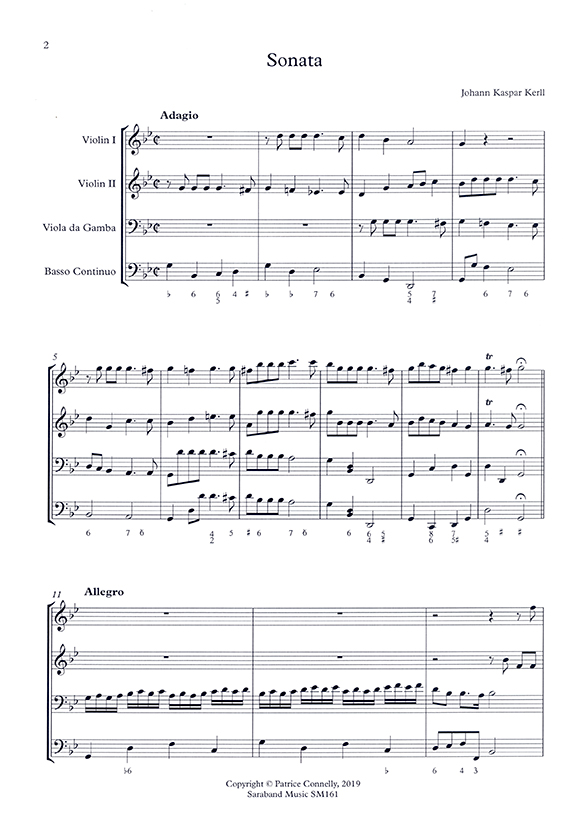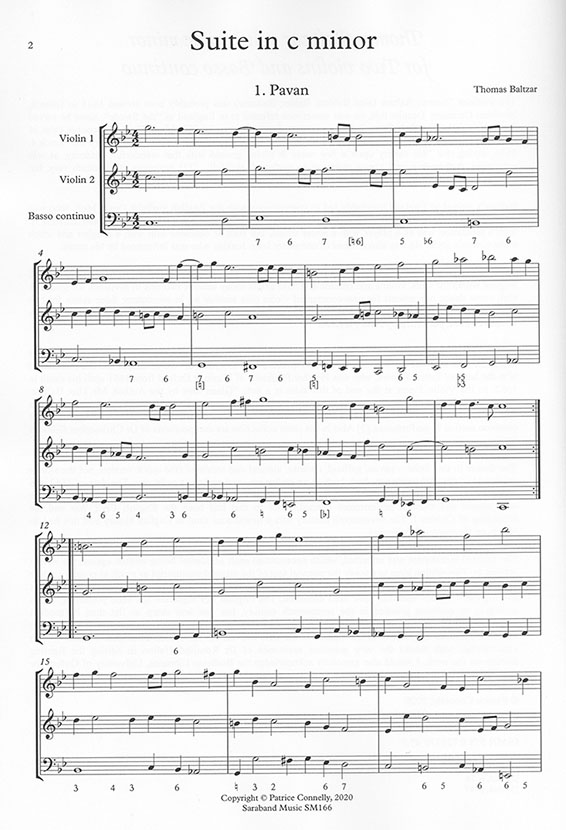Saraband Ensemble Editions


Prices on this page do not include Australian GST. Australian residents please add 10%
Ben Thorn has edited this sonata which can be performed on recorder/violin/flute/oboe with basso continuo. It comes from the first published set of Castello's works, dating from 1629. The continuo part has been realised, and a bass part is also provided.
This sonata is also from the 1629 set and alternative parts are provided for violin/cornetto or recorder/flute. Also edited by Ben Thorn.
This edition by Rosalind Halton is based on two mss in the Santini Collection in Munster. The cantata dates from June 1699. This edition comprises score and parts, with the keyboard part realised. A full translation is also provided.
A cantata for male alto voice, recorder, two violins and b.c. Edited by Rosalind Halton, this is great new repertoire for any countertenor.
From Rosenmuller's 1682 set of 12 sonatas, this lovely work was originally written for two violins & continuo, but it works really well for 3 bass viols, or for 2 bass viols with continuo instruments of your choice. Score and parts, including figures in the score and bass part. The continuo line is unrealised. The two solo lines were simply taken down an octave, and are in alto clef. An interesting work for professional performance.
Purcell's music for the 1691 publication of Dioclesian is famous. This piece originally for 2 flutes and b.c. from Act 3 has been transposed into a suitable key for viols. There's a simple keyboard realisation, or it can be played by 3 viols.
This is a great piece, and while this arrangement was intended for viols, it is perflectly playable on the violin family or a mixture of the two. Score & parts. See the Viol Consorts page for the sample page.
One of Purcell's last masques was The Indian Queen. This edition includes all of the four part music for two violins, viola and cello. The overture, various trumpet aires, and some dances. It could also be played on viols, but does require a slightly extended range.
Johann Kaspar Kerll composed two sonatas for 2 violins, gamba and continuo. This one was edited from a manuscript held in Uppsala University Library (with thanks for their permission to publish). This particular edition does not have a realised continuo part, but the realisation in the 1901 edition of Kerll's works in Denkmaler der Tonkunst in Bayern could be used if necessary. Score and parts.
Audio speeds are not necessarily correct.
This is a wonderful suite of twelve dances - pavan, galliard, ayre, almands, corants and sarabands, and was probably written in the late 1650s. There is a date on the violin 1 part where the copyist Edward Lowe, who was Heather Professor of Music at Oxford in the 1660s, which says "Given mee by the Author, Mr Tho: Baltzar October 1662". This edition is as faithful to the original as possible. The b.c. part is not realised, but is comprehensively figured. Only the first two dances had original figures, some of which were plainly wrong, so the figuring has been corrected and with the assistance of Dr Rosaline Halton, we have a very workable figuring throughout the entire suite.
This work has been recorded by The Locke Consort and is available on YouTube: https://music.youtube.com/watch?v=oER5n3DL0OM&list=OLAK5uy_lGkAKCvsnZP
UGUYzC5zCdjQNpGcKTVpFw will take you to the Pavan, and the rest of the Suite is on the sidebar.
This wonderful sonata is a typical baroque multi-movement work, but with a difference. Each stringed instrument gets a solo movement with continuo. The gamba part is mostly distinct from the continuo line and matches the violin parts in virtuosity. This edition is an urtext, coming as score and parts, but with an unrealised continuo. That part is comprehensively figured. Audio is of the first movement, and it's a trifle fast but will give you some idea of the piece.
Details for Qurino Colombani's cantatas Dimmi, ingrate Mirtillo, and Fra le Rose, edited by Rosalind Halton, with obbligato string parts and basso continuo, can be found on the Vocal page.
Sonatas settima and ottava, for 2 violins, viola, cello and continuo. Continuo line is figured and unrealised. Fantastic baroque multi-movement sonatas. Score and parts.
A new edition of this great trio sonata has been edited from the manuscript in the Duben Collection at the University of Uppsala. Two violins, gamba and continuo. Score and parts. Very worthy of performance.
This Trio sonata for 2 violins, bass instrument (bassoon, cello, bass viol) and basso continuo is a typical pleasing multi-movement work. The figured bass is not realised. Score and parts.
This is a substantial publication of sixteen pieces. A figured bass is included for completeness as it did appear in the 2nd edition. This edition was largely worked from Christophe Ballard's first printing of 1683. The gorgeous chaconne from Act 2 is here along with lots of other dances and great pieces. Score and parts. An extra set of parts is available on request for $24 (prices ex GST).
Audio is of the fantastic Chaconne from Act II and the little air that follows.
See also the Viol Consorts page and the Vocal page
Some of the viol consorts are playable by string trios, quartets etc. or possibly recorders.













